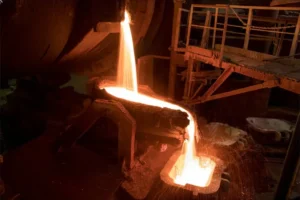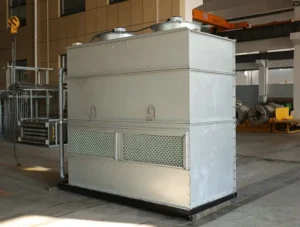Индукционные печи генерируют значительное количество пыли и паров во время процесса плавления, что не только серьезно загрязняет окружающую среду цеха и ставит под угрозу здоровье работников, но также может привести к штрафам за несоблюдение экологических норм.. Поэтому, крайне важно оборудовать индукционную печь высокоэффективной системой пылеулавливания.. В этой статье мы сравним различные типы промышленных пылесборников и углубимся в то, как спроектировать эффективные пылесборники, которые помогут вам построить чистую уборную., безопасный, и современный цех, соответствующий экологическим нормам.
Основной компонент: Сравнение типов промышленных пылесборников
Промышленный пылесборник является сердцем всей системы пылеудаления., и его выбор напрямую определяет конечную эффективность очистки.. Для индукционных печей, Двумя наиболее распространенными вариантами на рынке являются Рукавный пылесборник и Картриджный пылесборник.
1. Рукавный пылесборник
Рабочий принцип: Запыленный газ поступает в коллектор и фильтруется через подвесные фильтр-мешки.. Частицы пыли улавливаются на внешней поверхности мешков., при этом чистый газ проходит и выводится. Когда слой пыли на мешках достигает определенной толщины, механизм очистки, например, импульсно-струйный, выбивает пыль, который затем попадает в бункер внизу.
Преимущества:
- Высокий воздушный поток Емкость: Способен справляться с большим объемом дыма, образующегося в крупных индукционных печах..
- Устойчивость к высоким температурам: Можно использовать специальные фильтрующие материалы. (например, Р84, стекловолокно) выдерживать высокие температуры дымовых газов индукционных печей.
- Прочный и долговечный: Структура относительно проста, рукавные фильтры имеют длительный срок службы, и он может выдерживать суровые промышленные условия.
- Адаптация к свойствам пыли: Лучше подходит для работы с липкими, абразивный, или более крупные частицы.
Недостатки:
- Большой след: Требуется больше площади, чем для картриджного коллектора при той же площади фильтрации..
- Относительно низкая фильтрация Точность: Менее эффективно улавливает субмикронные частицы по сравнению с картриджными коллекторами..
- Комплексная замена сумки: Смена мешков часто требует выключения системы и входа в отделение., что неудобно.
2. Картриджный пылесборник
Рабочий принцип: Похоже на рукавный фильтр, но в качестве фильтрующего материала используются гофрированные фильтрующие картриджи.. Такая плиссированная конструкция значительно увеличивает площадь фильтрации на единицу объема..
Преимущества:
- Компактный дизайн, Малый размер: Идеально подходит для современных мастерских с ограниченным пространством..
- Высокая фильтрация Точность: Чрезвычайно эффективен при улавливании субмикронных частиц. (например, 0.3 мкм), что делает его пригодным для соответствия более строгим стандартам выбросов.
- Удобный Обслуживание: Картриджи обычно устанавливаются горизонтально или в выдвижной системе ящиков., делает замену быстрой и легкой без необходимости входить в коллектор, тем самым сокращая время простоя при техническом обслуживании.
- Энергоэффективный: Благодаря оптимизированной конструкции фильтрующего материала, они часто имеют более низкое рабочее сопротивление, что помогает снизить энергопотребление вентилятора.
Недостатки:
- Чувствителен к пыли. Свойства: Не подходит для липких, влажный, или маслянистая пыль, который может засорить (или “слепой”) картриджи.
- Ограниченная термостойкость: Стандартные картриджи имеют меньшую температурную устойчивость, чем специальные рукавные материалы.. Высокотемпературные дымы требуют предварительного охлаждения..
- Более высокие первоначальные затраты для больших потоков воздуха: Первоначальные инвестиции могут быть выше, чем в рукавный фильтр для применений, требующих очень больших объемов воздуха..
| Особенность | Рукавный пылесборник | Картриджный пылесборник |
| Рабочий принцип | Фильтрация тканевых мешков | Фильтрация плиссированных картриджей |
| Точность фильтрации | Хороший | Очень высокий |
| Производительность воздушного потока | Подходит для средних и больших объемов | Подходит для малых и средних объемов (Модульно расширяемый) |
| Температура. Сопротивление | Хороший (До 250°C+ или 482°F+) | Умеренный (Обычно < 120°С или 250°F) |
| След | Больше | Компактный |
| Обслуживание | Относительно сложный | Просто и быстро |
| Подходящая пыль | Широкий ассортимент, в том числе липкий & абразивная пыль | Лучше всего для сухого, нелипкий, мелкая пыль |
| Первоначальные инвестиции | От среднего до высокого | Середина |
| Эксплуатационные расходы | Середина | Относительно низкий |
Советы по выбору:
- Для крупномасштабный, печи непрерывного действия с высокими температурами дымовых газов и сложными свойствами пыли, тот Рукавный фильтр Пылесборник это более прочный и надежный выбор.
- Для малый и средний, печи периодического действия в ограниченных по пространству цехах с чрезвычайно строгими требованиями к выбросам, тот Картридж Пылесборник является идеальным решением благодаря своей высокой эффективности и удобству.. При выборе картриджеприемника, Крайне важно обеспечить достаточное охлаждение дымовых газов во избежание повреждения картриджей..
Критическая ссылка: Проектирование эффективного вытяжного шкафа для сбора пыли
“Если вы не можете это запечатлеть, ты не сможешь его собрать.” Пылесборник — первый и наиболее важный элемент, определяющий успех системы пылеудаления.. Плохо спроектированный вытяжной зонт приведет к попаданию большого количества паров в мастерскую., делая неэффективным даже самый мощный пылесборник.
Конструкция эффективной вытяжки должна соответствовать этим основным принципам.:
1. Подойдите как можно ближе к источнику
Это золотое правило дизайна капюшона.. Скорость воздуха в точке захвата уменьшается экспоненциально пропорционально квадрату расстояния от проема капота.. Уменьшение вдвое расстояния от источника до вытяжки может уменьшить требуемый поток воздуха примерно 75%, что означает меньший вентилятор, более низкое потребление энергии, и меньшие инвестиции в оборудование.
2. Форм-фактор имеет решающее значение
Для разных пылеобразующих точек индукционной печи следует подбирать разные типы колпаков.:
- Кольцевой колпак для горловины печи / Полузакрытая вытяжка: На этапах загрузки и плавления, вытяжка с боковой тягой или навес, или полузакрытая вытяжка со сдвижной крышкой, возможность установки над устьем печи. Эта конструкция эффективно окружает источник дыма., достижение высокой эффективности улавливания при меньшем потоке воздуха.
- Разливочная станция Качели Рука Капюшон: Во время шлакования и заливки, точка образования дыма перемещается. Кожух с поворотным рычагом и шарнирными соединениями можно гибко расположить непосредственно над рабочей точкой для точного захвата..
- Полный корпус Отрицательное давление Капюшон (Для наклонных печей): Для наклонных печей, большое ограждение или помещение может быть спроектировано таким образом, чтобы вместить всю рабочую зону во время заливки. Выпуская воздух из этого корпуса, создается отрицательное давление, предотвращение выхода дыма.
3. Используйте естественное движение дыма
Горячие дымы от индукционной печи естественным образом поднимаются вверх.. Поэтому, колпак должен быть расположен непосредственно над источником загрязнения работать с, не против, эта естественная плавучесть. Избегайте размещения точек всасывания сбоку или ниже источника..
4. Определите правильную скорость захвата
Скорость улавливания — это минимальная скорость воздуха, необходимая в точке образования пыли для преодоления потоков окружающего воздуха и втягивания загрязняющих веществ в вытяжной шкаф.. Для определения этой скорости необходимо учитывать:
- Свойства пыли: Размер частиц, плотность, и т. д..
- Окружающий Воздух Течения: Поперечные тяги от открытых дверей, люди проходят мимо, и т. д..
- Динамика процесса: Скорость выделения дыма на разных этапах, например, при зарядке., плавление, и постукивание.
В качестве общего руководства, скорость управления в рабочих точках индукционной печи должна быть не менее 0.5 – 1.5 РС (100 – 300 фут/мин).
5. Оптимизация структуры открытия капота
Добавление фланец или юбка до края проема капота позволяет существенно улучшить схему обдува, уменьшить потерю объема воздуха, и добиться того же эффекта захвата с меньшим потоком воздуха.
Соответствие стандартам выбросов в окружающую среду
Чтобы ваша система сбора пыли постоянно соответствовала стандартам соответствия., помимо выбора подходящего коллектора и проектирования отличной вытяжки, вы также должны сосредоточиться на:
- Расчет воздушного потока в системе: Точно рассчитайте необходимый расход воздуха для каждой точки захвата, учет сопротивления воздуховодов и оборудования, определить общий расход воздуха и статическое давление для вентилятора. Слишком слабый поток воздуха приводит к плохому захвату; слишком много энергии тратится.
- Проектирование воздуховодов: Расположение воздуховодов должно быть максимально прямым., минимизация изгибов и переходов. Скорость воздуха внутри воздуховодов должна быть достаточно высокой, чтобы пыль могла транспортироваться, не давая ей оседать. (обычно 15-20 м/с или 3000-4000 фут/мин).
- Стандарты выбросов: Понимать и соблюдать последние местные и национальные стандарты выбросов загрязнителей воздуха.. Ограничения на выбросы для промышленных печей становятся все более строгими, часто требуется концентрация твердых частиц ниже 30 мг/м³, или даже 10 мг/м³. Для этого требуется очень эффективный пылесборник..
- Онлайн-мониторинг и Обслуживание: Для больших систем, рассмотреть возможность установки оборудования онлайн-мониторинга для отслеживания концентрации выбросов в режиме реального времени.. Кроме того, разработайте комплексный план технического обслуживания для регулярной проверки фильтрующих мешков/картриджей., система очистки, и производительность вентилятора для обеспечения долгосрочной, эффективная работа.
В заключение, “очистка легких” вашего цеха индукционных печей – это системный проект. Все начинается с тщательного анализа условий вашей эксплуатации., сосредоточен на научном выборе пылесборника, и зависит от тщательной разработки каждого пылесборника.. Сочетая преимущества рукавного или картриджного коллектора с эффективной технологией улавливания источника., вы можете не только значительно улучшить окружающую среду в цехе и защитить здоровье сотрудников, но и уверенно соблюдать все более строгие экологические нормы., достижение устойчивого развития бизнеса.







